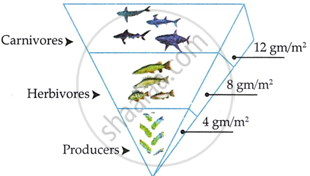Advertisements
Advertisements
Question
The Ecological pyramids may have an ‘upright’ or an ‘inverted’ shape. Justify with the help of suitable examples.
Justify
Solution
Ecological pyramids can be upright or inverted, depending on the environment and their particular trophic connections.
- Upright Ecological Pyramid:
- The upright position of ecological pyramids in most ecosystems indicates that biomass or energy levels drop as we go up the trophic levels.
- Example: The ecological pyramids of terrestrial ecosystems, such as forests and grasslands, are usually upright. For example, in a forest ecosystem, primary consumers (herbivores), secondary consumers (carnivores), and producers (plants) make up the broad base of the pyramid. Because energy is lost as one goes up the food chain, fewer organisms and biomass are supported at each trophic level.

- Inverted Ecological Pyramid:
- In certain ecosystems, especially aquatic ones, ecological pyramids may display an inverted configuration, wherein biomass or energy escalates as one ascends the trophic levels.
- Example: Marine ecosystems depend upon phytoplankton to maintain zooplankton, which in turn support smaller fish populations and larger predators. An inverted pyramid occurs when higher trophic levels (zooplankton and fish) have more biomass or energy than lower trophic levels (phytoplankton).

shaalaa.com
Is there an error in this question or solution?
